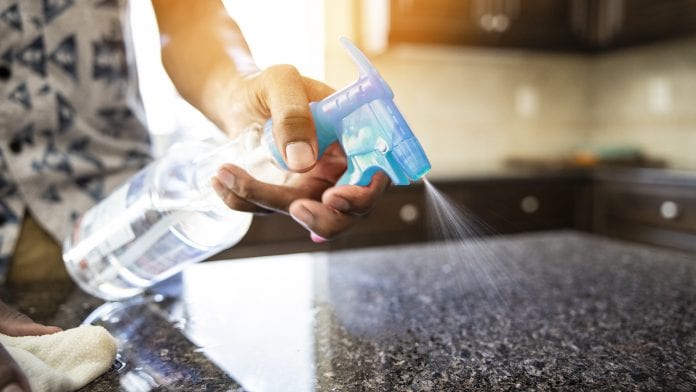
Are viruses, bacteria, or moulds in your home a threat to your family’s health? In this Special Report, Nova Biologicals explores the importance of food, air, and indoor hygiene to maintain good health.
The possibility of contaminants that can be harmful to one’s health and wellbeing in the home are many, and vigilance is required in order to mitigate the negative impact of pathogens that can be found indoors.
One significant area of concern for possible pathogenic contamination is in the kitchen during food preparation. Harmful bacteria cannot be seen, smelled, or tasted in foods, so proper handling is essential to preserving the health of individuals. The importance of a clean kitchen cannot be understated. Developing effective cleaning habits for countertops and food storage appliances is a great way to keep harmful bacteria from infecting food as it is prepared for consumption or lingering on common surfaces afterwards. Food handling safety guidelines should be followed using the four steps from the Food Safe Families campaign developed by the United States Department of Agriculture (USDA) in partnership with Department of Health and Human Services, FDA, CDC, and the Ad Council:
Hygiene safety guidelines
First, be sure to wash your hands and surfaces often. Second, ensure that cross contamination does not occur from food like raw meat. Next, be sure that all raw foods are cooked to the appropriate temperature and prepared correctly. Finally, refrigerate food promptly after use to prevent contaminant growth and food deterioration.
Following these steps for the safe handling of food during preparation will significantly reduce the chance of illness caused by bacteria that can be found in improperly prepared and stored foods. The USDA gives further guidelines for the safe handling of food, from shopping for food to the storage of leftovers on their website.
Another avenue of pathogen transmission is through kitchen appliances. Ice makers can harbour bacteria as well as coffee makers, water lines, faucets, and sinks. Ensuring that these appliances are cleaned and maintained is one of the best deterrents to the possibility of water-borne illness.
 Indoor air quality
Indoor air quality
Indoor air quality can be a significant concern for many individuals.
According to the United States Environmental Protection Agency (EPA), “Indoor Air Quality refers to the air quality within and around buildings and structures, especially as it relates to the health and comfort of building occupants.”
Individuals with sensitivities to allergens are more susceptible to the negative effects of poor indoor air quality. Short term immediate reactions to indoor pollutants range from irritation of the eyes, nose, or throat to headaches, dizziness, and fatigue. More serious health issues can cause permanent damage with long-term effects that can present themselves immediately upon contact with pollutants or even years after exposure to the irritants, such as respiratory diseases, heart diseases or cancer.
The pollutants that can contribute to both short-term and long-term effects are many and varied. Some examples are the thousands of products that emit Volatile Organic Compounds (VOCs). Volatile organic chemicals, which are dangerous gases that can be emitted by certain chemicals like paint or glue, are widely used in household products and fuels and the compounds can be released upon use and, to some extent, even while in storage.
Health effects from VOCs range from minor irritation of the eyes, nose, and throat to extreme reactions such as visual disorders and memory impairment. Levels of VOCs will average two to five times higher in the indoor environment than outdoors and can reach levels 1,000 times higher when performing activities such as painting or paint stripping.
For this reason, it is always recommended to increase ventilation when using chemicals indoors. Labels on household products provide valuable information and useful tips for reducing the possibility of over-exposure to VOCs while using them. The level of VOC emissions from a product is dependent on several factors, such as the age of the product or the temperature at which the product is used or stored. How the product is used can also contribute to the level of air contamination by the product, making it important to read product labels for proper use instructions. The Berkeley Lab is a good source of information on indoor air quality, with links to scientific findings updated as more studies are performed on VOCs as they relate to health.
Other reasons for poor indoor air quality could be related to inadequate ventilation, the use of tobacco products, and excess moisture. Heart disease and stroke are leading causes of death in the United States and air pollution can contribute to both of these conditions.
Using air filtration systems
Air filtration systems performing at optimum capacity have the ability to remove air-borne pathogens before those pathogens can become a health threat to building occupants. Those systems require regular cleaning and maintenance in order to ensure that they remain in good working order.
An additional benefit of a properly working air filtration system is that the humidity level can be regulated in the indoor environment. Allowing the humidity level to remain high in an indoor environment can encourage the growth of mould. Moulds are organisms that grow best in dark, damp environments and are an important part of the outdoor environment, breaking down dead leaves and plants. However, mould that grows indoors can cause damage to the home as well as causing health issues for the inhabitants.
Those that suffer with allergies can be susceptible to the effects of the spores that moulds produce, which become air-borne and can quickly become dispersed throughout the home through the air circulation system. Once the spores are dispersed, they can latch on to damp surfaces and begin to grow and produce even more spores. Negative health effects from inhaling mould spores range from sneezing, a runny nose, eye irritation, and skin rash, to more serious effects such as shortness of breath. Those with asthma may experience an asthma attack from breathing air polluted with mould spores. The best defence against mould growth is the cleaning and maintenance of air filtration systems, including regular air filter replacement, as well as consistent cleaning of any surfaces that are wet or damp, such as showers, toilets, sinks, and faucets.
Quality drinking water
The quality of drinking water is of utmost importance to the continued good health of the entire human race.
In 2017, according to the World Health Organization (WHO), 71% of the global population has access to a safely managed drinking water service. Access to safe water, as defined by the WHO, is that the water is located on the premises, available when needed, and is free from contamination.
The remaining 29% of the global population faces challenges (from minor to significant) in order to access clean water. 785 million people worldwide lack even the most basic drinking water service, with 144 million of those dependent on surface water for their water needs. Even if one does not depend upon rivers and streams for drinking water, those bodies of water should still be protected from pollution caused by the dumping of waste.
The WHO produces guidelines for the quality of drinking water and provides support for protecting existing sources, the development of new water sources, and global efforts to recover water, nutrients, and energy from water sources that are being increasingly stressed by population growth and demographic changes.
It is estimated that by the year 2025, 50% of the world’s population will be living in water stressed areas. The WHO has noted that: “Management of all water resources will need to be improved to ensure provision and quality.”
Inadequate water management can lead to the misuse and contamination of a water source which has the potential to infect many people with any number of diseases. Legionellosis, cholera, diarrhoea, dysentery, hepatitis A, typhoid, and polio are all water-borne diseases that can be prevented with proper water management. Water contaminated with faeces is used by at least two billion people worldwide, and contaminated water can contain parasites such as Cryptosporidium, Giardia, and schistosomes. Infection by these parasites cause intestinal illness.
People in least developed countries are focused on obtaining clean water for sustaining everyday life. In developed countries where clean water is more readily available, water for public use in swimming pools, splashpads, and fountains must be monitored in order to maintain the integrity of that water. These public venues rely on diligent cleaning and maintenance protocols to protect the health of those that would enjoy the use of these facilities. Maintaining a clean water supply for consumption is crucial and involves the routine cleaning and maintenance of water pipes, dispensers, faucets, and appliances and water testing in the home environment is a good idea in order to verify the effectiveness of both the cleaning procedures of the water system suppliers and the maintenance and cleaning effectiveness of the indoor environment.
Being aware of the potential for negative health effects caused by indoor contamination goes a long way towards preserving the good health of one’s family. Observing proper food handling practices will ensure that meals shared with family and friends are free from any harmful bacteria, and awareness of how air filtration systems clean the air breathed indoors can allow for the proper maintenance of those systems keeping air-borne pathogens from finding a home indoors.
Finally, working together to preserve the precious natural resource of water will ensure that safe drinking water will be available to all, both now and in the future.
To find out more about how Nova Biologicals’ microbiological testing services can help you, please visit www.novatx.com

























